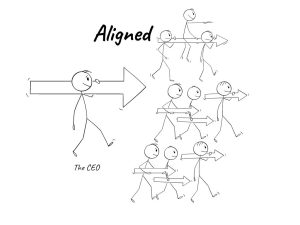
How to Get Everyone on Board: Align Your Staff, Board & Community
Before my gluten-free days, I used a bread machine to make school lunches. Most mornings, we’d wake to the smell of fresh bread. On days when we forgot the yeast, it smelled like dawn smelled like burnt toast.
Failing to align your nonprofit is like skipping yeast when making bread. You combine the ingredients and hit start. Instead of your goal, you get a hot mess. You get:
- Staff Conflicts: Lack of respect, teamwork, and buy-in. Complaints about others not contributing and silos.
- Board Issues: Too involved in day-to-day or not engaged. Without alignment, they warm seats or pick tasks (usually yours).
- Leadership Vacuums: Individuals take control without direction and choose their own paths.
There’s more, but that’s enough to grasp that failing to align is a kind of Pandora’s box. Let’s double back and make sure we’re aligned about what we mean by alignment.
What is Alignment?

Dr. Otis Fulton and Katrina VanHuss define it this way, “when every member of an entire group is aware of and agrees on the group’s direction.”
Why Don’t You Hear More About It?
It’s overlooked and often invisible. Author and search firm expert Dennis C. Miller calls it an “innovative concept.” I beg to differ. I find it consistently in thriving nonprofits. It seems innovative because we fail to see and name it as a critical ingredient of success.

What Happens When It’s Missing?
Tired staff, board mischief, and CEO burnout.
For instance, CEOs try to get individuals and groups to move in the right direction instead of operating within common agreements.
In its best form, alignment shapes and becomes part of your organization’s culture, resulting in progress in your three bottom lines. Instead of “culture eating strategy for breakfast” (Peter Drucker), alignment meshes culture and strategy to play together.
What Does Alignment Do?
It answers four big questions for you and your staff, board, and supporters:
- What are we doing?
- Where are we going?
- What am I supposed to do, and why does it matter?
- What’s everyone else doing?
When people get laser-clear about these answers, progress is underway.
From the CEO’s viewpoint, alignment based on common ground shifts daily operations to being more staff-propelled, giving CEOs time for 20 percent of their work–the best things for the nonprofit’s top executive to do.

If answers to these questions and CEO benefits aren’t enough, let’s turn to employee recruitment and retention, where alignment also shines.
What Does Alignment Do for Staff?
Brown and Yoshioka found that “Perceived mission alignment helps attract employees…” and Kim and Lee saw that mission orientation between nonprofit employees and the organization significantly influences employee retention.
Perhaps this is not surprising because employees are attracted to nonprofit missions, and keeping employees requires living out the mission—and making “the sausage” is messy.
I’ve never seen Jason so engaged. I‘m thrilled, because a lot of the execution is within his purview.
Life is just better when everyone knows what they are doing, why they are doing it, and how their work contributes to a nonprofit’s vision.
How Do You Get Alignment?
Alignment comes from finding common ground. You find common ground by including those who will execute or support your work, listening, and incorporating what you discover in your work.
Alignment is an intentional product of quality teamwork or planning. You build it in focus groups, community meetings, staff and board retreats, strategic planning, strategic minis, and community planning (cultural plans.)
What is the #1 best way to generate alignment? Hire a skilled consultant with facilitation, strategy, and event expertise. I’ve worked with thousands of nonprofits and CEOs on planning and alignment processes.
Check Your Alignment
1. How aligned is your organization on a one to ten scale, with ten high?
2. Rank these groups from most aligned to least in your nonprofit:
- staff
- donors
- volunteers
- board
- funders
3. What tangible benefits do you see from alignment in your nonprofit?
When you ready, here’s how to set up a chat to talk about your nonprofit.
Karen Eber Davis is a nonprofit strategic planning consultant who works with visionary leaders committed to taking their organizations to new heights. She offers customized strategies, assessments, and coaching designed to help leaders lead their organizations to achieve their potential. She is the author of 7 Nonprofit Income Streams and Let's Raise Nonprofit Millions Together.
Categories
If you appreciate these Added Value posts, please consider subscribing.
Latest Posts
- How New Nonprofit CEOs Secure Board Buy-In for Strategic Planning
- How Nonprofit Leader Navigate Crisis with Clarity & Confidence
- One Way AI Can Help You Find a Path Where None Exists
- In Crisis? Resist Cutting Your Ability to Make Income
- Nonprofit Strategic Planning Assessment: 10 Questions About Your Strategy
